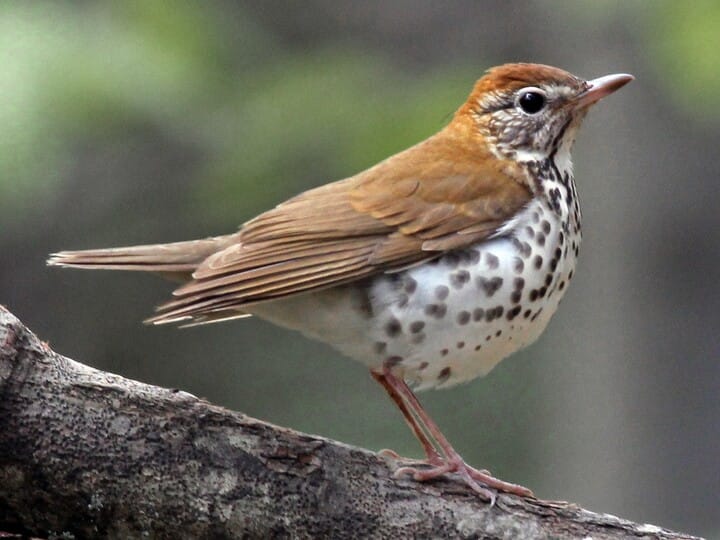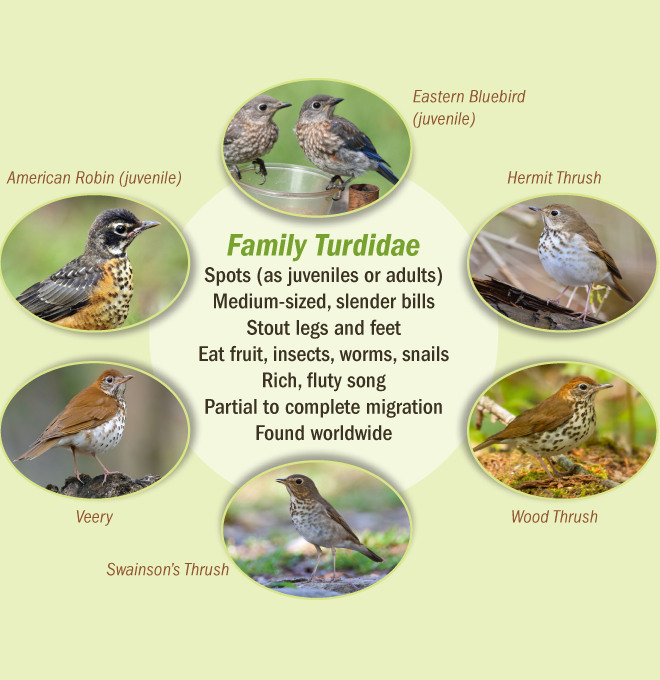Bird enthusiasts often compare the Wood Thrush and Hermit Thrush. Both birds have unique features and beautiful songs.
Understanding these differences can help bird watchers identify them better. Comparisons between bird species, like the Wood Thrush and Hermit Thrush, are useful for many reasons. Bird watchers can learn to spot the unique traits of each bird. This makes bird watching more enjoyable and educational.
Knowing the differences also helps in understanding their behavior and habitat preferences. Whether you are a seasoned birder or a beginner, this guide will provide clear insights into these two fascinating birds. Let’s explore what sets the Wood Thrush and Hermit Thrush apart.

Credit: www.allaboutbirds.org
Physical Characteristics
When comparing the Wood Thrush and the Hermit Thrush, their physical characteristics can provide fascinating insights. These two birds may seem similar at first glance, but with a closer look, unique traits emerge. Understanding their differences can enhance your bird-watching experience and deepen your appreciation for these creatures.
Size And Shape
The Wood Thrush is slightly larger, measuring around 7.5 to 8 inches in length. Its body is more robust, with a rounded head and a straight bill. This bird has a strong, sturdy appearance.
In contrast, the Hermit Thrush is a bit smaller, about 6.5 to 7 inches long. It has a more delicate build, with a slender, upright posture. The Hermit Thrush’s bill is also straight, but its overall shape is more slender and graceful.
Size and shape can be tricky to judge in the field, but with practice, you can start to notice these subtle differences. Have you ever tried comparing the two side by side? It’s a great way to sharpen your identification skills.
Coloration
The Wood Thrush has a distinct coloration that sets it apart. Its back and wings are a warm reddish-brown, while its underparts are white with bold, dark spots. These spots are most prominent on the chest, giving it a striking appearance.
The Hermit Thrush, on the other hand, has a more subdued color palette. Its back is a brownish-olive, and its underparts are lighter with faint spots. The most distinguishing feature is its reddish tail, which contrasts with its brown back.
Observing these color patterns can be a fun challenge. Next time you’re out bird-watching, pay attention to the tail color and spotting on the chest. These clues can help you identify which thrush you’re looking at.
Understanding these physical characteristics not only aids in identification but also enhances your overall bird-watching experience. What other differences have you noticed between these two thrushes? Share your observations and engage with other bird enthusiasts in the comments below!
Habitat Preferences
Understanding the habitat preferences of the Wood Thrush and Hermit Thrush can greatly enhance your birdwatching experience. Each of these birds thrives in specific environments, which can help you know where to look when you’re hoping to spot one. Let’s dive into the unique habitats that these birds call home.
Wood Thrush Habitats
The Wood Thrush is often found in deciduous forests. They prefer areas with a dense understory of shrubs and saplings. This offers them ample cover and nesting sites.
Look for them in moist, shady environments. They are particularly fond of riparian zones, which are the areas along rivers and streams. These spots provide a rich diet of insects and fruit.
Interestingly, I once noticed that Wood Thrushes are also quite adaptive. During a hike in an urban park, I spotted a Wood Thrush in a forested area near a small creek. It made me realize how these birds can sometimes thrive even in semi-urban settings.
Hermit Thrush Habitats
The Hermit Thrush, on the other hand, is more versatile in its habitat preferences. You can find them in both deciduous and coniferous forests. They seem to have a particular liking for areas with a mix of forest types.
During migration, they can be spotted in open woodlands, parks, and even backyards. This adaptability makes them easier to find in different seasons.
One winter, I was surprised to see a Hermit Thrush in my backyard, hopping around under a holly bush. It made me wonder how these birds choose their temporary homes. Have you ever noticed their distinct behavior during different times of the year?
Understanding these habitat preferences not only helps in spotting these birds but also in appreciating the diversity of environments that support their lives. Next time you go birdwatching, keep these tips in mind to increase your chances of seeing a Wood Thrush or Hermit Thrush. Happy birdwatching!
Behavioral Traits
Understanding the behavioral traits of Wood Thrush and Hermit Thrush offers insights into their unique characteristics. These birds exhibit distinct habits that set them apart. Let’s delve into their feeding habits and mating and nesting behaviors.
Feeding Habits
Wood Thrushes prefer to forage on the forest floor. They search for insects, spiders, and snails. Occasionally, they eat small fruits and berries.
Hermit Thrushes also forage on the ground. They mainly eat insects, caterpillars, and beetles. In winter, they switch to eating berries and fruits.
Mating And Nesting
Wood Thrushes build their nests in the lower branches of trees. They use mud and plant material to construct their nests. Females lay 3-4 eggs and incubate them for about 12-14 days.
Hermit Thrushes prefer to nest on the ground or low bushes. Their nests are made of twigs, moss, and leaves. Females lay 3-5 eggs and incubate them for 12-13 days.
Both species are known for their distinct and melodious songs. These songs play a key role during the mating season.
Vocalizations
The Wood Thrush and Hermit Thrush are known for their beautiful songs. These birds have distinct vocalizations that make them unique. The songs play a crucial role in their identification and appreciation. Let’s delve into the melodious world of these thrushes.
Wood Thrush Songs
The Wood Thrush is famous for its flute-like song. This bird’s song is rich and melodious. It often consists of a series of phrases. Each phrase has a unique pattern. The Wood Thrush uses its syrinx to create harmonies. These harmonies are complex and beautiful. The bird sings at dawn and dusk. It may also sing after rain. This song is often described as ethereal and enchanting.
Hermit Thrush Songs
The Hermit Thrush has a different song from the Wood Thrush. Its song is more haunting and delicate. The Hermit Thrush’s song starts with a clear, single note. This note is followed by a series of trills. Each trill rises and falls in pitch. The Hermit Thrush sings in a series of phrases. These phrases have a flute-like quality. The bird often sings from a hidden perch. It sings mostly during the morning and late afternoon. The song of the Hermit Thrush is calming and serene.
Migration Patterns
Understanding the migration patterns of the Wood Thrush and Hermit Thrush can be fascinating for bird enthusiasts. Both species are known for their distinct songs and beautiful appearance. However, their migration habits differ significantly, which can be intriguing to explore.
Seasonal Movements
The Wood Thrush typically migrates in the spring and fall. They usually spend their summers in the eastern United States and migrate to Central America for the winter. This ensures they avoid the harsh winter conditions and have access to abundant food sources.
In contrast, the Hermit Thrush has a more varied approach to migration. While some populations migrate long distances to the southern United States and Mexico, others only move short distances. This behavior allows them to adapt to different environmental conditions and food availability.
Geographical Range
The geographical range of the Wood Thrush during breeding season includes deciduous and mixed forests of the eastern United States. They prefer areas with dense understory where they can find insects and berries. This preference impacts their migration patterns as they seek similar habitats in Central America.
Hermit Thrushes, on the other hand, are more adaptable. They can be found in a wide range of habitats, from coniferous forests to mixed woodlands. This adaptability allows them to have a broader geographical range, extending from Alaska and Canada to as far south as Guatemala during winter.
Have you ever wondered why some birds undertake such long migrations while others stay closer to home? Observing these patterns can provide insights into the adaptability and survival strategies of different species. Understanding these differences can enhance your bird-watching experience and deepen your appreciation for these remarkable creatures.
Conservation Status
The Wood Thrush and Hermit Thrush, two beloved songbirds, face different conservation challenges. Understanding their conservation status helps us protect these charming birds. Let’s explore their population trends and protection efforts.
Population Trends
The Wood Thrush population has declined significantly over the past decades. Habitat loss and fragmentation are major threats. This bird depends on large, continuous forests. When forests are cut down, Wood Thrushes lose their homes.
In contrast, the Hermit Thrush population remains more stable. They are less dependent on large forests. Hermit Thrushes can adapt to different habitats. This adaptability gives them a better chance of survival.
Protection Efforts
Efforts to protect the Wood Thrush include habitat preservation. Conservationists work to save large forest areas. Reforestation projects are also crucial. Planting trees helps restore lost habitats.
For the Hermit Thrush, protecting diverse habitats is key. They thrive in various environments. Ensuring these habitats remain intact supports their population.
Both birds benefit from reducing pesticide use. Pesticides kill the insects they eat. Using fewer chemicals helps keep their food sources plentiful.
Public awareness campaigns also play a role. Educating people about these birds raises support for conservation actions.
Tips For Identification
Identifying Wood Thrush and Hermit Thrush can be challenging for bird enthusiasts. Both species share similar features and habitats. Yet, there are distinct characteristics to help you tell them apart. This section will provide tips to identify these beautiful birds with ease.
Field Marks
Wood Thrushes have a rich, rusty-brown color on their upper parts. Their underparts are white with bold black spots. Hermit Thrushes, on the other hand, have a more muted brown back. Their underparts are whitish with finer, more evenly spaced spots. Also, Hermit Thrushes have a reddish tail, which stands out against their duller back.
Behavioral Cues
Observing their behavior can also help in identification. Wood Thrushes are often seen hopping on the forest floor. They tend to stay in dense, moist woodlands. Hermit Thrushes are more solitary and can be found in a wider range of habitats. They often flick their wings and tail, a key distinguishing behavior.
Pay attention to these tips during your birdwatching adventures. With practice, you will become more confident in identifying these charming birds.

Credit: wildbirdstore.com

Credit: www.birdwatchingdaily.com
Frequently Asked Questions
What Is The Difference Between A Hermit Thrush And A Wood Thrush?
The Hermit Thrush has a reddish tail and spots on its chest. The Wood Thrush has a more uniform brown color and a distinct song.
How Do You Identify A Wood Thrush?
Identify a Wood Thrush by its reddish-brown upper body and white underparts with dark spots. Listen for its beautiful, flute-like song.
What Is Another Name For A Wood Thrush?
Another name for a Wood Thrush is Hylocichla mustelina. It is often referred to simply as the Wood Thrush.
How To Tell The Difference Between Thrushes?
Identify Thrushes by their size, color, song, and habitat. Look for distinct markings on the chest and wings.
Conclusion
Choosing between a Wood Thrush and a Hermit Thrush can be tough. Both birds have unique songs and habits. Wood Thrushes prefer deep forests, while Hermit Thrushes can be found in mixed habitats. Their songs also differ, with the Wood Thrush having a flute-like tune, and the Hermit Thrush singing a clear, melodious song.
Watching these birds can bring joy and a sense of peace. Enjoy observing both and appreciate their beauty. Your bird-watching experience will be richer with this knowledge. Happy birding!
